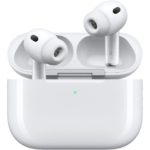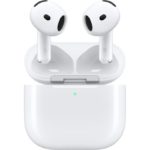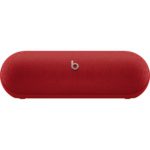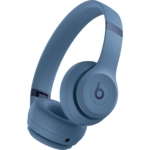The new Apple AirPods Pro 3 improve ANC, comfort, and bass while adding a heart rate sensor and USB-C charging. Our full review reveals why they remain the best true wireless in-ears for iPhone users.
We repeatedly read all sorts of mysterious abbreviations in the manufacturers’ specifications of Bluetooth headphones when it comes to sound quality. We also list the codecs used in our tests. SBC, aptX or AAC are often mentioned. You might already know that they compress your music to different levels. But which codec is better? We want to give you a short and concise overview to help you decide.
Short history
Before we briefly discuss the respective codecs, we’ll start with a brief digression, because we all use Bluetooth every day as a matter of course without knowing exactly what it stands for. Sure, Bluetooth (named after the Danish king Harald Blauzahn, who united parts of Norway and Denmark, the logo is the monogram of the old Norse runes “B” and “H”) transmits data wireless. In order for the transmission to take place as efficiently as possible, the power consumption as well as the computing power must be as low as possible. This was quite sufficient for the first Bluetooth applications – music transmission, however, was not the main goal of the wireless transmission technology in the first generation.
But Bluetooth is not a rigid standard, rather it is constantly redefining itself with new versions. So we have now arrived at version 5. The introduction of a special low-energy profile significantly reduces energy consumption and thus enables longer music listening. This profile, also called “Bluetooth Low Energy,” “Bluetooth LE” or “BLE,” is a wireless technology that was developed independently and released back in 2009 as an optional part of Bluetooth version 4.0. However, Bluetooth Low Energy is not backwards compatible, so Bluetooth devices must also support BLE.
Bluetooth has profile(s)
To transmit audio, Bluetooth was initially only used in conjunction with headsets. So-called “profiles” regulate the audio streams, which are strongly restricted in their frequency response: “HSP” means “Headset Profile”, and takes care of basic functions that are important for smooth communication between headset and device. The profile “HFP” (for “Hands free Profile”) is slightly more sophisticated and defines the smooth cooperation between cell phone and handsfree device installed in the car. So if you read the two abbreviations in the technical specifications, it’s nothing special and doesn’t say anything about the transmission quality of your music.
More important are the two following profiles, which are called “A2DP” and “AVRCP“. The first one, the “Advanced Audio Distribution Profile”, only enables the transmission of two different channels, i.e. stereo, with a considerably better encoding than “HSP” and “HFP”. The “Audio/Video Remote Control Profile”, “AVRCP” for short, is only responsible for control: It sends commands like “Play”, “Pause” or “Skip Title” from the headphones to your smartphone.
Profiles have to be supported by both sides to work, and they bring all the technical devices involved to the same table so that everyone plays by the same rules. But the quality of the game is decided by the codec!
Bluetooth has class
Although the range that can actually be achieved with Bluetooth connections depends on many factors (design, environment, etc.), it can generally be divided into three classes: Class 1 transmits with a maximum of 100 milliwatts and manages a range of up to 100 meters outdoors. Class 2 works with only 2.5 milliwatts, its range is up to 50 meters in open air under ideal conditions, but 10 meters is much more realistic. Class 3 is the most power-efficient variant: Here, only 1 milliwatt is required, but it is only enough for a few meters (up to 10 meters with visual contact). In general, less is always desirable, it reduces the strain on the battery.
What does a codec actually do?
When it comes to Bluetooth, codecs take care of compressing audio signals. The digital signals are divided into different frequency bands, and these are then encoded depending on its signal level. This saves a lot of space, but is so lossy that you might hear it.
And here the same applies as with the profiles: Both sides, transmitter and receiver, must support the codec.
SBC
SBC, also called “Low Complexity Subband Codec”, is part of the Bluetooth profile “A2DP” (see above). Its (lossy) compression makes comparatively low demands on the hardware and therefore requires little computing power. The use of the code SBC is license-free, so it is often used. The sound quality is good if high bit rates are delivered, but loses quality quickly if the receiver is weak or there are obstacles (e.g. walls, air, distance) between the devices. Its maximum sample rate is 48 kHz (but mostly only 44.1 kHz is used), at 16 bit and at a data rate of max. 345 kb/s.
LC3 & LC3plus
The Bluetooth Special Interest Group had announced the next generation of Bluetooth Audio at CES 2020 in Las Vegas (as we reported here on our german website). “LE Audio” is the name of the new version, and it is said to improve Bluetooth audio performance and provide enhanced support for hearing aids and audio sharing. LE Audio includes a new audio codec, the Low Complexity Communications Codec (LC3). This is intended to replace the old SBC codec known from Classic Audio (see above). LC3 offers high quality even at low data rates and supports sampling rates up to 48,000 Hz and sampling rates up to 24 bit. The enhanced LC3plus codec goes one step further and supports 24bit/96kHz.
aptX
aptX was developed back in the 1980s at Queen University in Belfast, later bought by technology company CSR, which in turn was bought by Qualcomm in 2015. The codec is not free, those who want to use it in their devices have to pay license fees. The manufacturer might be familiar to many of you when the name “Snapdragon” is used: This CPU is found in very many Android smartphones, so they are also capable of aptX. The advantage of the codec is its fixed bit rate of 354 kbit/s, a better compression performance (i.e. a lower compression rate) and a resulting better sound quality. However, this necessarily requires that all devices in the game are capable of the Bluetooth add-on standard EDR – “Enhanced Data Rate”, which offers a bit rate of up to 2.1 Mbps. Don’t worry, almost all headphones are EDR-capable. A quick check of the technical data or a request to the manufacturer should also give you some certainty!
aptX HD
It gets even better with the suffix “HD”. With a sampling rate of 48 kHz and a resolution of 24 bits, the quality is theoretically higher than that of the CD. In addition, there is a lower risk of dropouts. But: Smartphones and headphones with aptX HD are still quite rare, the PX from Bowers & Wilkins (review) or the Beyerdynamic Aventho Wireless (review) support this codec.
aptX Low Latency, aptX Live
Qualcomm is constantly developing its codecs further, and there are now several variants that are all tailored to certain application scenarios. The low latency codec is supposed to provide perfect sync for time-critical applications such as games or movies. aptX Live mainly addresses live applications on stage, which rely on extremely low latency when wireless microphones and headphones interact.
aptX Adaptive
In the fall of 2018, Qualcomm introduced the new codec aptX Adaptive. The benefit of this enhancement is its automatic adjustment of compression ratios when different usage scenarios are involved. Since audio transmission is less time-critical for phone calls than for mobile gaming or streaming Netflix, aptX Adaptive can independently perform the optimal encoding.
aptX Lossless
At the beginning of September 2021 Qualcomm’s new codec “aptX Lossless” got released. This enhancement based on the aptX Adaptive Codec is part of the Snapdragon Sound audio platform introduced at the beginning of 2021. aptX Lossless can upscale to lossless CD audio quality – depending on the quality of the Bluetooth connection – and the user can choose between lossless CD audio (44.1 kHz) and lossy 24-bit audio (96 kHz). The codec works with Qualcomm’s “Bluetooth High Speed Link technology” to ensure the required data throughput. This is the only way to achieve data rates of up to 1 Mbps, but in congested wireless environments it should be able to easily scale down to 140 kbps to minimize audio dropouts or interference and ensure a consistent and reliable listening experience.
AAC – Advanced Audio Coding
Developed by the Motion Picture Experts Group (MPEG), this codec is said to be the high-quality successor to MP3, as more accurate error correction and more efficient coding algorithms better compress audio material. Here, too, license fees are due, but AAC even supports up to 48 tracks, which makes it usable for surround applications. Apple, for example, relies on AAC for their mobile devices, while their computers support aptX.
LDAC
Sony has developed LDAC, a technology that can transmit high-res audio content with a maximum transfer rate of 990 kbps. A depth of 24 bits and a sampling rate of 96 kHz currently exhausts what is technically feasible, but unfortunately this codec is currently only found in a few products. For example, the Sony WH-1000XM5, the Huawei FreeBuds 5i or the Soundcore Space A40 by Anker are among the few that support this transmission codec.
LHDC
The LHDC (codec) was developed by Savitech Corp. and, like Sony’s LDAC, allows high-quality audio streaming with low latency. It supports up to 24-bit and 96 kHz audio with a bit rate of up to 900 kbps. Among others, the OnePlus Buds Pro 2 support this high-resolution codec.
Samsung UHQ-BT
Samsung has also turned the codec screw and, with UHQ-BT, has an algorithm in its program that, like Sony, supports up to 24 bits and 96 kHz. However, UHQ-BT is not widespread, but those who only use Samsung’s products might be happy with the Bluetooth headphones Level One Pro in combination with a Samsung smartphone.
Similar Reviews
The Beats Powerbeats Pro 2 are the “AirPods Pro” for athletes, representing a significant update compared to the 2019 predecessor.
Slightly smaller, improved sound and H2 chip from the Pro model – the new Apple AirPods 4 are a successful upgrade.
The Beats Pill is sturdy, runs for up to 24 hours and is a real eye-catcher, but it lacks a bit of sound.
In our test, the Beats Solo 4 proved to be very good-sounding on-ears that operate at a high technical level, which impressed us with their long battery life.














